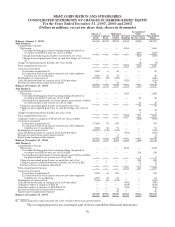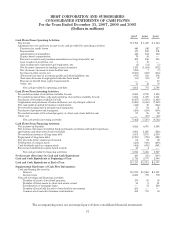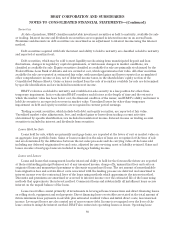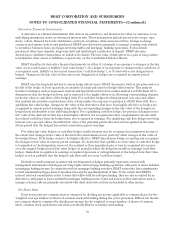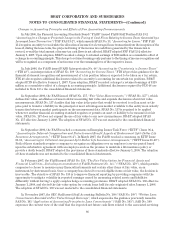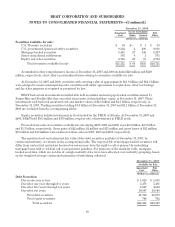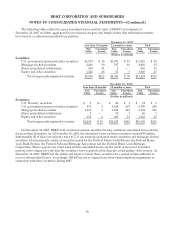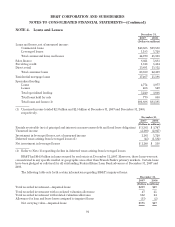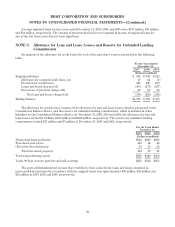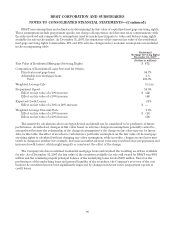BB&T 2007 Annual Report Download - page 86
Download and view the complete annual report
Please find page 86 of the 2007 BB&T annual report below. You can navigate through the pages in the report by either clicking on the pages listed below, or by using the keyword search tool below to find specific information within the annual report.BB&T CORPORATION AND SUBSIDIARIES
NOTES TO CONSOLIDATED FINANCIAL STATEMENTS—(Continued)
Changes in Accounting Principles and Effects of New Accounting Pronouncements
In July 2006, the Financial Accounting Standards Board (“FASB”) issued FASB Staff Position FAS 13-2
“Accounting for a Change or Projected Change in the Timing of Cash Flows Relating to Income Taxes Generated by a
Leveraged Lease Transaction” (“FSP FAS 13-2”), which amends SFAS No. 13, “Accounting for Leases.” FSP FAS
13-2 requires an entity to recalculate the allocation of income for a leveraged lease transaction from the inception of the
lease if, during the lease term, the projected timing of the income tax cash flows generated by the transaction is
revised, even if the total amount of income tax cash flows is not affected. BB&T adopted FSP FAS 13-2 effective
January 1, 2007. Upon adoption, BB&T recorded a charge to retained earnings of $306 million as a cumulative effect of
a change in accounting principle. This charge to retained earnings only pertains to the timing of income recognition and
will be recognized as a component of net income over the remaining lives of the respective leases.
In July 2006, the FASB issued FASB Interpretation No. 48 “Accounting for Uncertainty in Income Taxes”
(“FIN 48”), an interpretation of SFAS No. 109 “Accounting for Income Taxes.” FIN 48 provides guidance for the
financial statement recognition and measurement of a tax position taken or expected to be taken on a tax return.
FIN 48 also requires additional disclosures related to an entity’s accounting for uncertain tax positions. BB&T
adopted FIN 48 effective January 1, 2007. Upon adoption, BB&T recorded a charge to retained earnings of $119
million as a cumulative effect of a change in accounting principle. Additional disclosures required by FIN 48 are
included in Note 13 to the consolidated financial statements.
In September 2006, the FASB issued SFAS No. 157, “Fair Value Measurements,” (“SFAS No. 157”), which
defines fair value, establishes a framework for measuring fair value and expands disclosures about fair value
measurements. SFAS No. 157 clarifies that fair value is the price that would be received to sell an asset or the
price paid to transfer a liability in the principal or most advantageous market available to the entity in an orderly
transaction between market participants on the measurement date. SFAS No. 157 is required to be applied
whenever another financial accounting standard requires or permits an asset or liability to be measured at fair
value. SFAS No. 157 does not expand the use of fair value to any new circumstances. BB&T adopted SFAS
No. 157 effective January 1, 2008. The adoption of SFAS No. 157 was not material to the consolidated financial
statements.
In September 2006, the FASB reached a consensus on Emerging Issues Task Force (“EITF”) Issue 06-4,
“Accounting for Deferred Compensation and Postretirement Benefit Aspects of Endorsement Split-Dollar Life
Insurance Arrangements,” (“EITF Issue 06-4”). In March 2007, the FASB reached a consensus on EITF Issue
06-10, “Accounting for Collateral Assignment Split-Dollar Life Insurance Arrangements,” (“EITF Issue 06-10”).
Both of these standards require a company to recognize an obligation over an employee’s service period based
upon the substantive agreement with an employee such as the promise to maintain a life insurance policy or
provide a death benefit. BB&T adopted the provisions of these standards effective January 1, 2008. The adoption
of these standards was not material to the consolidated financial statements.
In February 2007, the FASB issued SFAS No. 159, “The Fair Value Option for Financial Assets and
Financial Liabilities—Including an amendment of FASB Statement No. 115,” (“SFAS No. 159”), which permits
companies to choose to measure many financial instruments and certain other items at fair value, on an
instrument-by-instrument basis. Once a company has elected to record eligible items at fair value, the decision is
irrevocable. The objective of SFAS No. 159 is to improve financial reporting by providing companies with the
opportunity to mitigate volatility in reported earnings caused by measuring related assets and liabilities
differently without having to apply complex hedge accounting provisions. BB&T adopted SFAS No. 159 effective
January 1, 2008, and elected the fair value option for certain loans held for sale originated after January 1, 2008.
The adoption of SFAS No. 159 was not material to the consolidated financial statements.
In November 2007, the SEC Staff issued Staff Accounting Bulletin No. 109 (“SAB No. 109”) “Written Loan
Commitments Recorded at Fair Value through Earnings”, which supersedes the guidance previously issued in
SAB No. 105 “Application of Accounting Principles to Loan Commitments” (“SAB No. 105”). SAB No. 109
expresses the current view of the staff that the expected net future cash flows related to the associated servicing
86


